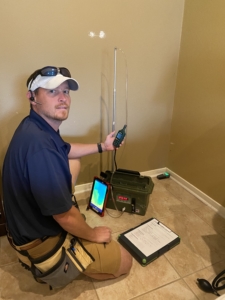What to Expect From Your Mold Inspection
Whether you are buying, selling or maintaining your home, Singular Mold Inspections provides professional and quality service from the moment you call. We will walk through your home together and teach you as much as you want to learn. We strictly follow the International Association of Certified Indoor Air Consultants standards of practice.
1.0 Scope
1.1 The purpose of this standard is to provide standardized procedures to be used for a mold inspection. There are two types of mold inspections described in the IAC2 Mold Inspection Standards of Practice:
(1) Complete Mold Inspection (Section 2.0)
(2) Limited Mold Inspection (Section 3.0)
1.2 Unless the inspector and client agree to a limitation of the inspection, the inspection will be performed at the primary building and attached parking structure. Detached structures shall be inspected separately.
1.3 A mold inspection is valid for the date of the inspection and cannot predict future mold growth. Because conditions conducive to mold growth in a building can vary greatly over time, the results of a mold inspection (examination and sampling) can only be relied upon for the point in time at which the inspection was conducted.
1.4 A mold inspection is not a home (property) inspection.
1.5 A mold inspection is not a comprehensive indoor air quality inspection.
1.6 A mold inspection is not intended to eliminate the uncertainty or the risk of the presence of mold or the adverse effects mold may cause to a building or its occupants.
————————————————————————————————————
2.0 Complete Mold Inspection
2.1 The inspector shall perform:
– a non-invasive visual examination of the readily accessible, visible, and installed systems and components of the building (listed in Section 4.0 Standards of Practice)
– moisture, temperature and humidity measurements (refer to Section 4.8 Moisture, Humidity, and Temperature)
– mold samples according to the IAC2 Mold Sampling Procedures (refer to Section 5.0 IAC2 Mold Sampling Procedures)
2.2 The inspector shall report:
– moisture intrusion,
– water damage,
– musty odors,
– apparent mold growth, or
– conditions conducive to mold growth;
– results of a laboratory analysis of all mold samplings taken at the building; and
– any system or component listed in Section 4.0 Standards of Practice that were not inspected and the reason(s) they were not inspected.
————————————————————————————————————
3.0 Limited Mold Inspection
The limited mold inspection does not include a visual examination of the entire building, but is limited to a specific area of the building identified and described by the inspector. As a result, moisture intrusion, water damage, musty odors, apparent mold growth, or conditions conducive to mold growth in other areas of the building may not be inspected.
3.1 The inspector shall describe:
– the room or limited area of the building in which the Limited Mold Inspection is performed
3.2 The inspector shall perform:
– a limited non-invasive visual examination of the readily accessible, visible, and installed systems and components located only in the room or limited area (as described in previous Section 3.1).
– mold samples according to the IAC2 Mold Sampling Procedures (see Section 5.0 IAC2 Mold Sampling Procedures)
3.3 The inspector shall report:
– moisture intrusion,
– water damage,
– musty odors,
– apparent mold growth, or
– conditions conducive to mold growth; and
– results of a laboratory analysis of all mold samplings taken at the building



